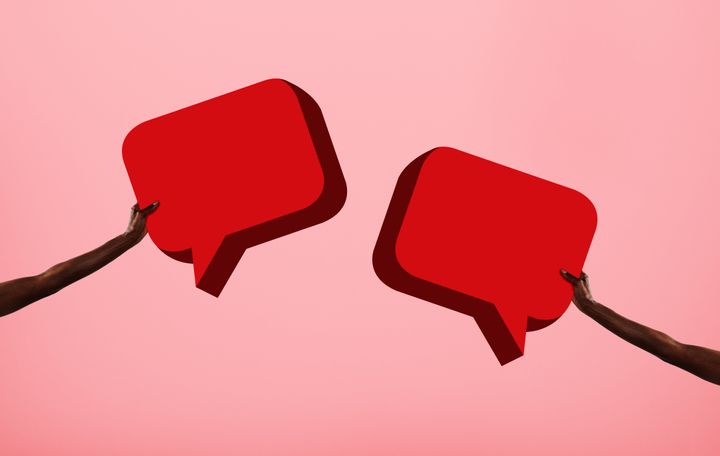
Nothing fills some of us with more anticipatory dread than having to talk to someone new.
We figure we’ll have nothing in common with the person. We’ll bumble through the conversation like Hugh Grant in a ’90s rom-com or say something that could be perceived as offensive, especially if the person seems outwardly different from us (a different generation, religion, socioeconomic status or education level, for instance).
The fear is commonplace, according to Juliana Schroeder, an assistant professor at the University of California, Berkeley, Haas School of Business whose research explores how people make social inferences about others. Many assume they’ll be ill-equipped to chat up the person sitting next to them at a dinner party, at a networking function or on public transportation, she told HuffPost.
“Many of us think we’ll run out of things to say more quickly than we actually do, and that makes us misestimate the hedonic trajectory of the conversation,” Schroeder said. (That’s a PhD way of saying how enjoyable the conversation will be over time.)
When it comes to conversations with strangers, Schroeder knows her stuff. A 2014 study she co-authored used bus and train interactions to understand why people routinely ignore each other rather than look for common ground. (A crowded bus is filled with people from all walks of life, so it’s a particularly good place to study interactions.)
“We tested several possible psychological reasons for why people believe that talking to strangers will be unpleasant and found the most evidence for two reasons: concerns about social rejection and pluralistic ignorance,” she said.
In the study, pluralistic ignorance is defined as the belief that others are less interested in connecting with us than we are in connecting with them.
“Everyone in our experiments said they would be more willing to talk than they thought others would be willing to talk,” Schroeder said.

When it came to social rejection, most participants in the study believed that more than 50% of the people they approached would refuse to talk to them, but actually less than 5% of participants said that this happened to them.
“The fear of being socially rejected appears to be outsized,” Schroeder said. “People think that others don’t want to talk because they aren’t talking ― instead, others are wearing their headphones or playing with their phones. But just because they are doing that doesn’t mean they wouldn’t be interested in talking.”
Jeanne Martinet, author of “Mingling With the Enemy: A Social Survival Guide for Our Divided Era,” thinks that the majority of people have what she refers to as “minglephobia” ― a fear of talking to strangers at social gatherings.
“The unknown is always scary, but I think when it comes to talking to new people we are either afraid of looking foolish ― that we will say something stupid or be completely tongue-tied ― or are afraid of getting stuck in a conversation we’d rather not be in,” she told HuffPost.
The truth is, talking to people we don’t know can be as “invigorating and mind-expanding as traveling to far-off places is,” Martinet said.
Still, we’re working against strong evolutionary impulses. As humans, we have an evolutionary drive to form cohesive social groups, self-identify, then stick to those groups. Social tribalism, as it’s called, can play out in our political affiliations, religion, place of residence and social status.
This sense of tribalism affects our social health and adds to a growing divisiveness among Americans. Making the effort to talk to people outside your bubble ― people who don’t look like you or worship like you, or watch the same news channel as you ― is a way to bridge the divide.

“We need to reach outward rather than retreating inward,” Martinet said. “The best kind of socialising doesn’t just lead to meeting new people, it leads to hearing different ideas and getting new information, hopefully forming new relationships.”
Still a little anxious about chatting up a stranger? Below, Martinet and other experts share their best advice for talking to someone you seemingly have nothing in common with.
Go into the conversation assuming the other person will be interesting.
Check your assumptions about how similar you may or may not be at the door, said Georgie Nightingall, the founder of Trigger Conversations, an organisation that offers events and training to help people create more meaningful conversations.
“Adopt a mindset that everyone is interesting and it is up to you to find out in what way,” she said. “This way your mind will be primed for discovery and curiosity.”
Going into a conversation with that kind of openness ― and making a goal of finding out in what way someone is interesting ― can be a game-changer.
So, too, is understanding that you don’t have to have anything in common with someone to relate to them or find them interesting. You just need to be curious and have a desire to understand how the other person has experienced life, Nightingall said.
“I don’t have to like their favourite hobby, for instance, to talk about it,” she said. “I can see it as an opportunity to learn about what they like about it.”
Become a great listener.
As a business entrepreneur in her early 30s, Dianna Booher began consulting for senior executives twice her age. During the day, Booher would lead two-day executive retreats and workshops. The evenings and all the social events she was required to go to were a different story.
Her thought process walking into all those social gatherings was always, “What could I possibly have to offer that would intrigue?”
“I knew these executives had much more business expertise and international travel experience than I did at that point in my life,” said Booher, who’s the author of “Communicate With Confidence.” “In my mind, everything I considered saying seemed mundane, simplistic and ‘beneath’ their level of interest.”
Eventually she learned the trick to establishing a quick rapport: She didn’t need to supply fascinating conversation; she just needed to be a good listener. (It’s true; a 2017 Harvard Business School study found that asking questions, particularly follow-up questions, is the key to mastering small talk.)
“Most people love to talk about themselves ― so let them,” Booher said. “Ahead of any potential uncomfortable situation, prepare some general questions. Then ask away.”
Listen carefully, show interest and ask intelligent follow-up questions, she said: “The person will walk away thinking you are the best conversationalist they’ve ever met!”

Come armed with a cheat sheet of good generic questions.
If question-asking really is the cornerstone of smooth conversation, cut yourself some slack and have some generic questions at the ready, said Debra Fine, the author of “The Fine Art of Small Talk: How to Start a Conversation, Keep It Going, Build Networking Skills ― and Leave a Positive Impression.”
“The worst time to come up with something to talk about is when there is nothing to talk about,” she said.
Consider questions about hot topics in the news, a new trend you saw on TikTok, the holidays or pandemic life.
You could also use the open-ended “what keeps you busy” prompt, Fine said. For instance:
What keeps you busy outside of work?
What keeps you busy outside of your kids?
What keeps you busy outside of this class?
Fine said to remember to ask some follow-up questions or encouraging statements, too. Things like:
“I see what you mean.”
“That sounds like fun”
“What happened next?”
“Give me an example of what you mean by that ...”
Don’t be afraid to share something deeper about your personal life.
It’s been proved that emotional self-disclosure can increase intimacy: You share something that occurred in your personal life ― even something that made you feel vulnerable ― and the other person feels a greater sense of connection.
If you want someone else to share the “real” them and go beyond surface-level small talk, you may have to go first with self-disclosure, Nightingall said.
“Sharing something that is meaningful to you ― who you really are, your thoughts, feelings and experiences ― can open the door and invite someone else to be their authentic self,” she said.
What you share doesn’t have to be something embarrassing from your past or some slip-up you made the other day. When meeting someone new, you can self-disclose even if all they ask you is, “How are you?”
“When someone asks that, I always share something meaningful about what I have been up to today, how I am feeling or what I am thinking,” Nightingall said. “It helps others become curious about me, and it invites others to reciprocate.”

Prepare for the worst case scenario.
If you do find yourself butting heads with someone with different views than yours, especially on a controversial issue, remember that it’s usually more valuable to make a connection with a person than it is to try to prove that you’re right. That’s certainly true if it’s a workplace conversation.
If you’re wholly at odds, Martinet recommended “side-stepping” away from the subject that ran the conversation aground.
“In other words, rather than having a violent argument with someone who is
passionately on the opposite side of an issue like climate change, you
can side-step to talking about the worst snowstorms you both remember as
a child, or the fact that people who live in rainy climates end up
getting fewer wrinkles,” she said.
Sometimes you’ll have to take several side-steps before you can continue forward productively, she said.
But go into the conversation expecting good things.
Prepare for the worst ― especially if you’re someone who relishes feeling prepared ― but go into the conversation expecting the best. Research has shown that talking to new people is a big mood booster, even if we fear going into the conversation initially, Schroeder said.
“Our study showed that the average person who talks to a stranger reports a happier mood,” she said. “People who were randomly assigned to talk to a stranger reported feeling happier afterwards compared to people assigned to do whatever they want ― which usually involves not talking to a stranger.”
We’ve all been there: Somehow, you’ve found yourself in a conversation with a person you have nothing in common with, someone who intimidates you or someone who won’t stop complaining. These kinds of interactions can be uncomfortable, to say the least. Our HuffPost series How to Talk to Just About Anyone will help you navigate these conversations and others. Go here for all the latest.